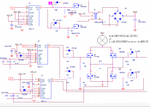ratheeshvaram@yahoo.com
Junior Member level 3

hai every one,
I am designing a variable inverter, output- 100V-300V, (40Hz-70Hz) 10W and input-12V,1A. for this I chose one DC-DC converter and DC-AC converter.
my first step is to get a max. DC voltage from DC-DC converter, give the output of this converter to the supply voltage of MOSFET in DC-AC converter Hbridge, provide a SPWM signal according to the desired output AC voltage, and finaly design a filter to get pure AC wave.
in DC-DC converter: I use pushpull topology (50Khz) , PIC16F716, IR2113 (driver), IRF3205 (MOSFET). the outpout of transformer is fed to the bridge rectifier (UF4007) and finally to a filter 47uF/400V. I got the output as ~400VDC, when i connected an LED through 200K resistor.
-duty cycle is 50%.
-10K is used form gate to ground
-using a 0.01uF and 56ohm (snubber) in parallel to primary.
In the DC-AC converter: I use full bridge topology (30KHz), PIC 16F716, IR2113 (driver), IRF830 (MOSFET). I use only 60 devision for sin wave generation. when I am connecting 12V in place of MOSFET supply, I am getting a SPWM signal across a 1K resistor, and nearly 8V AC on multimeter.
But when I connected the DC-DC converter output to MOSFET supply, the two MOSFET in one side of H Bridge burned.
I used 22uF/50V (electro) in parallel to 0.1uF as bootstrap cap.
-the load is 1K resistor
-the ground is common for entire circuit.
-12K is connected from gate to source.
-no snubber connected.
-uploading the schematic is not easy as we have to follow many company. rules, But I had verified the circuit of both DC-DC and DC-AC converter with many EDABOARD blogs...
friends what will be the reason for MOSFET burning...???
is any one feel something wrong in above explanation???
I am designing a variable inverter, output- 100V-300V, (40Hz-70Hz) 10W and input-12V,1A. for this I chose one DC-DC converter and DC-AC converter.
my first step is to get a max. DC voltage from DC-DC converter, give the output of this converter to the supply voltage of MOSFET in DC-AC converter Hbridge, provide a SPWM signal according to the desired output AC voltage, and finaly design a filter to get pure AC wave.
in DC-DC converter: I use pushpull topology (50Khz) , PIC16F716, IR2113 (driver), IRF3205 (MOSFET). the outpout of transformer is fed to the bridge rectifier (UF4007) and finally to a filter 47uF/400V. I got the output as ~400VDC, when i connected an LED through 200K resistor.
-duty cycle is 50%.
-10K is used form gate to ground
-using a 0.01uF and 56ohm (snubber) in parallel to primary.
In the DC-AC converter: I use full bridge topology (30KHz), PIC 16F716, IR2113 (driver), IRF830 (MOSFET). I use only 60 devision for sin wave generation. when I am connecting 12V in place of MOSFET supply, I am getting a SPWM signal across a 1K resistor, and nearly 8V AC on multimeter.
But when I connected the DC-DC converter output to MOSFET supply, the two MOSFET in one side of H Bridge burned.
I used 22uF/50V (electro) in parallel to 0.1uF as bootstrap cap.
-the load is 1K resistor
-the ground is common for entire circuit.
-12K is connected from gate to source.
-no snubber connected.
-uploading the schematic is not easy as we have to follow many company. rules, But I had verified the circuit of both DC-DC and DC-AC converter with many EDABOARD blogs...
friends what will be the reason for MOSFET burning...???
is any one feel something wrong in above explanation???




